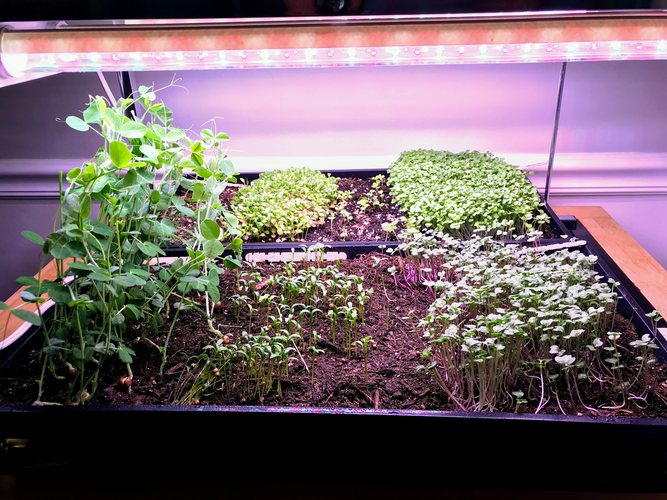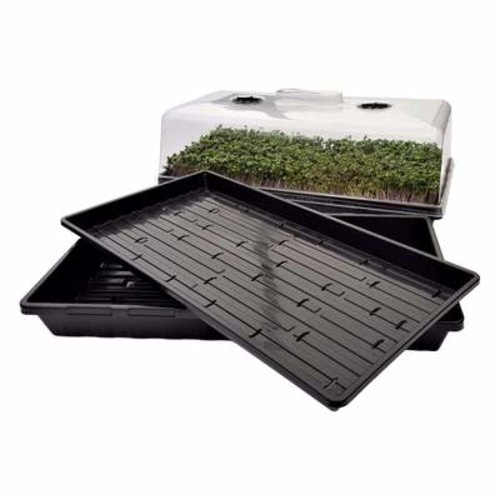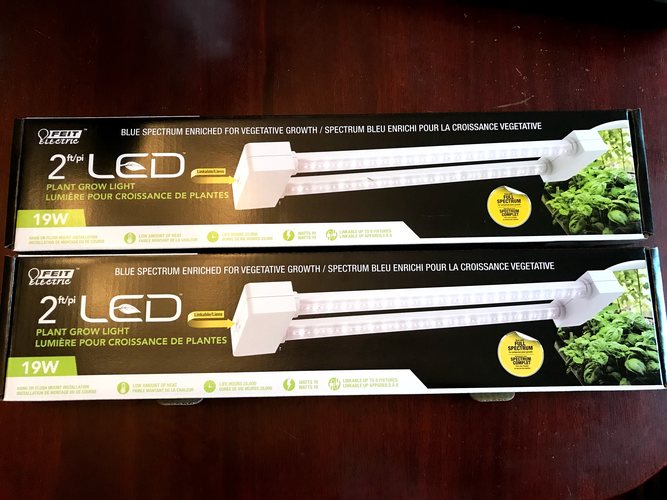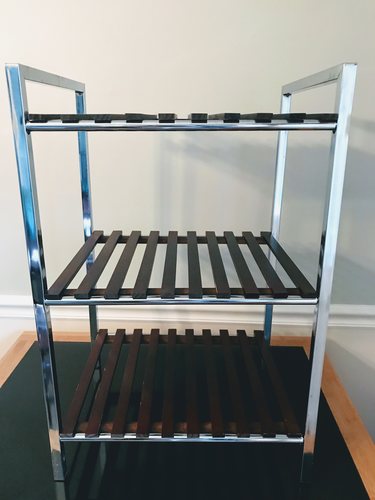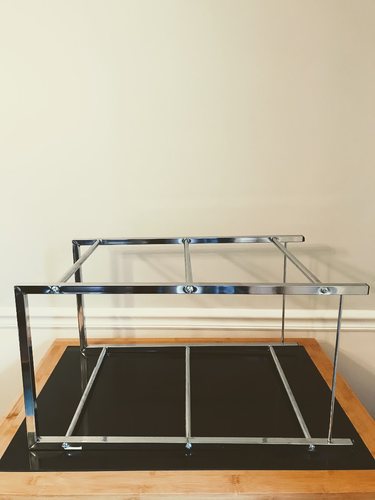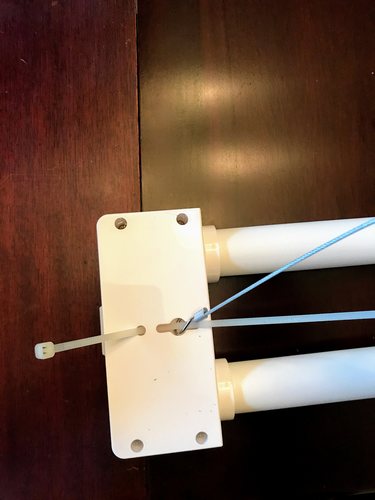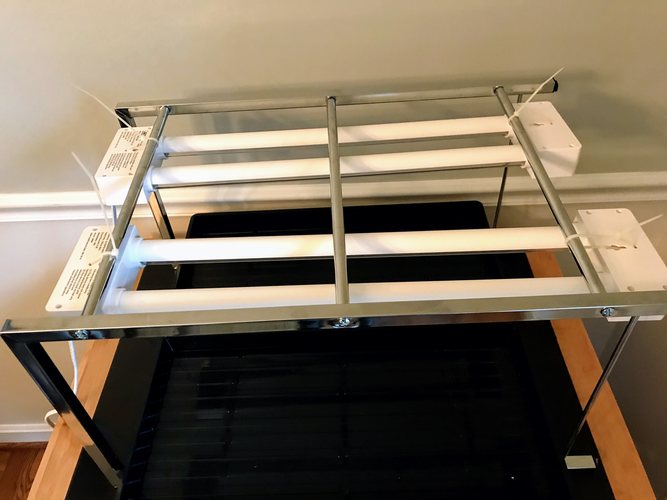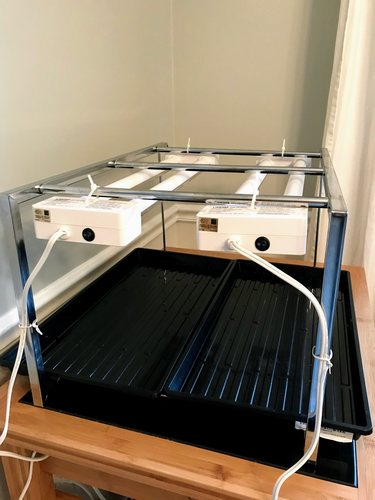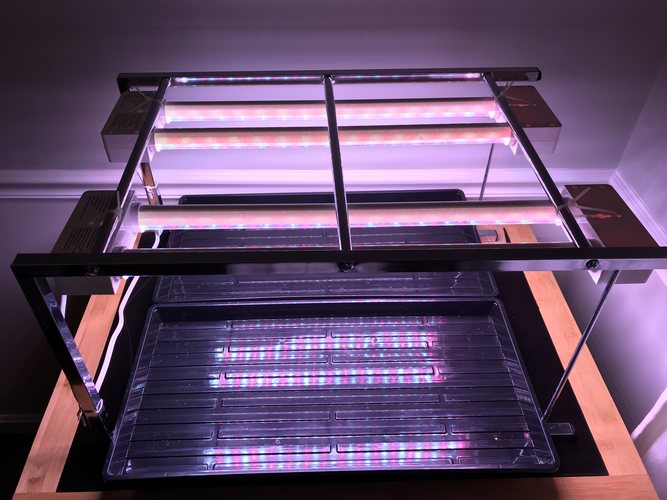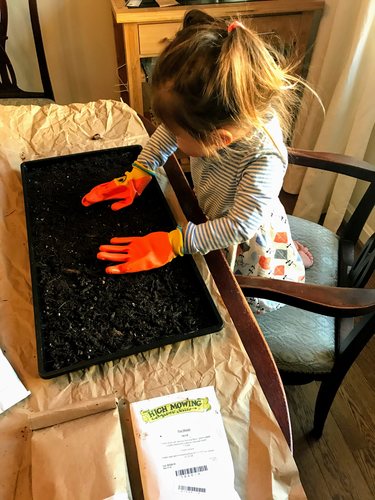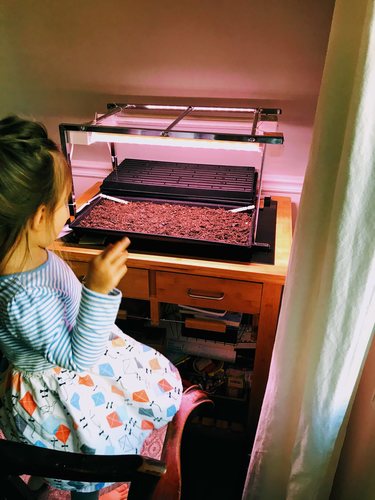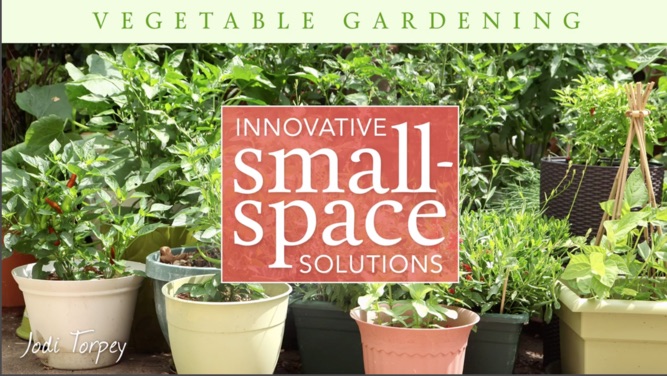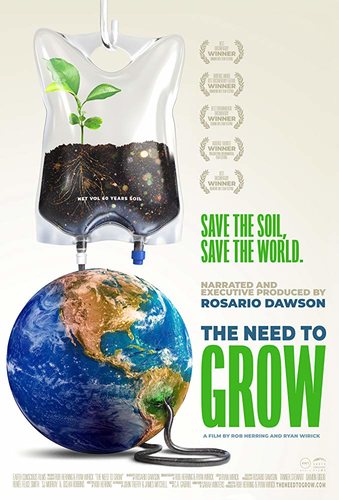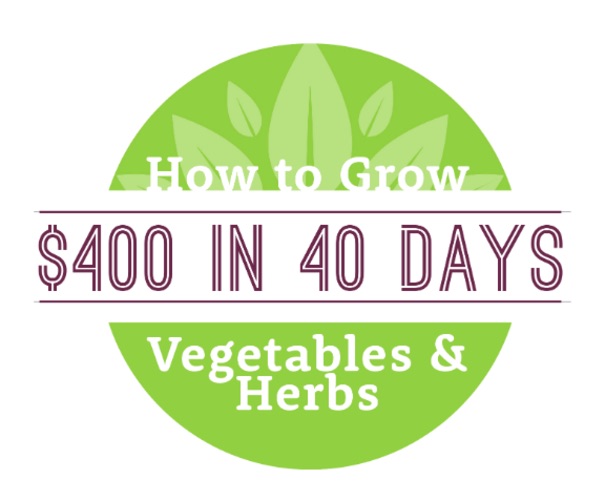Super Simple System To Growing Vegetables Indoors
It’s not hard. Growing vegetables without sunlight means you’ll need a shelving unit, grow lights, containers, potting mix, and seeds. That’s it.
Gardening is all about taking that initial leap. Along the way you’ll learn so much through trial and error. Read about my gardening journey here.
If you want to grow indoors with natural light, you’ll need a south-facing window. I tried growing on my kitchen windowsill (north-facing) and failed.
The only large enough south-facing window we have is full of houseplants, so my only choice was to set up grow lights.
Table of Contents
Building My First Grow Light System
Growing Vegetables Indoors Without Sunlight: Choosing Your Container
The first thing I decided on was the container in which I’d plant my seeds. You can repurpose any container lying around your house. Wanting to grow microgreens, I went looking for long and shallow trays.
Bootstrap farmer says, the “shallow tray is 1¼” high making it easy to cut microgreens at bottom of stem to maximize harvest.”
You can grab free trays from your local nursery, but I wanted a sturdy tray to use over and over again without them cracking or breaking.
I found 1020 trays from Bootstrap Farmer that are great. They are thick, BPA Free, and made of Food Safe #5 PP Plastic.
1020 trays are also great because they fit perfectly under a 2 ft. long grow light.
Growing Vegetables Indoors Without Sunlight: Choosing Grow Lights
You can get lost reading all the materials out there on grow lights. As I will mention later on, a gardening expert, Stacey Murphy, made it super easy.
If you’re growing leafy vegetables indoors without sunlight, you’ll want blue light.
She recommended either a high lumens, low watt fluorescent light or an LED light like the one below.
If you install lights that can’t be pulled up or down, simply use books to stack the tray closer to the light. Remember to keep the plants no farther than 6″ away from the light.
Plants should never touch the light either.
Plants will need 12-16 hours of light, so turn them on when you wake up and turn them off right before bed.

$40 LED Grow Lights
I bought two Feit Electric LED lights from Home Depot. They were $40 each. I like the way LEDs look compared to fluorescent lights. These in particular were very easy to set up out of the box, look modern, and do not get hot at all (bonus if you have young kids).
Growing Vegetables Indoors Without Sunlight: Choosing Shelving
Repurposing a Shelf
I didn’t want to buy a new shelf so walked around my house with a tape measure trying to see what could hold my tray. The 1020 tray is 21” x 10.75” x 2.5” deep. The bookshelf I intended to use was too narrow and too short to fit the trays and the grow light.
We have a rolling table in our dining room that is large enough to fit not one, but two 1020 trays. Perfect – more plants to grow! Now I have to find another place for my daughter’s backpack…
All I needed was a frame to put on top of the table, so I could attach the grow lights. The other option was to screw them into the ceiling and have them dangling above the table, which I didn’t want to do.
Buying Second-Hand Goods
Not wanting to spend a ton of money, I thought about second-hand goods, and went to Goodwill. I’ve watched so many home reno shows on HGTV, and naively thought I’d walk in to find the perfect unit to house my grow lights and trays.
Sadly, I walked out disappointed.
Then, I walked into our local hardware store to ask for advice. If you live close to Falls Church, VA and want knowledgeable and helpful staff, head to Brown’s Hardware. They are my go-to team when it comes to building or fixing something around the house.
One of the guys at Brown’s walked up and down the aisles with me trying to think of a way to make a frame. We considered using PVC pipe, metal wire, and leftover hardwood slabs.
Unfortunately, the hardwood slabs they offered were too small for my project. While they didn’t have all the materials I needed, they did help me think through how to build the frame.
With that vision in mind, I went back home and started looking around my house again. I walked into the basement and there was a small shelf in the bathroom. Ordinarily, this shelf was for guests’ toiletry bags or towels.
I’d now take it and reuse it for my grow light frame! Sorry overnight guests. You’ll have to store your goodies elsewhere.
I removed the wooden pieces and was left with a solid metal frame. When I turned the frame on it’s side, I inserted the two 1020 trays and they fit perfectly.
Growing Vegetables Indoors Without Sunlight: Setting Up Grow Lights
The LED lights came with mounting supplies; however, I didn’t use them as they were intended because I wasn’t able to screw anything into the metal frame. Instead, I used zip ties (found a whole bag stashed away by my husband’s tools) to connect the lamps to the frame.
For the next part, the mounting supplies came in handy. I looped the zip ties through the frame of the light and used one of the included hooks to pull the zip tie through the other end.
It took a few tries to get this to work and by the fifth try, I felt as much anxiety as I had as a child playing that Hasbro Operation doctor game.
After pulling all four zip ties tightly around the frame, I took a pair of scissors and cut the extra ends of the zip ties. No one likes sharp edges when you have kids running around the house.
I then used the twist ties that came with the lights and wrapped the electrical cords to the frame.
I plugged them in and turned them on. As you can see below the light covers each tray completely. Isn’t it pretty?
There was so much satisfaction in simply looking at this indoor garden with the lights turned on. I felt so accomplished already.

Homemade grow light system.
Growing Vegetables Indoors Without Sunlight: Choosing Your Seeds and Planting
Look for easy to grow vegetables that don’t need a lot of vertical growing space, so they fit under your grow lights.
Use potting mix labeled with OMRI and/or CDFA certifications. These certifications ensure substances and materials used in the production or handling of organic agricultural products by farmers and processors are suitable for organic food production.
Don’t use garden soil. This is better for outdoor gardening.
What did we grow first?
In one tray we planted pea shoots, cilantro microgreens, and broccoli microgreens. My daughter grabbed a handful of seeds and just scattered them throughout the tray.
In the other tray we planted an encore lettuce mix (green oakleaf, red oakleaf, green romaine, red romaine, lollo rossa, red leaf, and bibb lettuces) and mizuna.

Gently pressing seeds into soil.
My daughter dropped the seeds into the trays, but one mistake here is that we planted the seeds too densely and didn’t take into account the shallow trays. Microgreens definitely were more forgiving.
Lettuce is easy to grow. We just didn’t use a container deep enough. This encore lettuce needed at least six inches to grow.

Doing a happy gardening dance after turning on the grow lights.
Resources Used To Setup Up My First Indoor Garden
Bluprint Online Courses
I like a solid foundation when I do anything and have found online courses to be great resources for beginners. One course I bought in 2015 was from Bluprint called “Vegetable Gardening: Innovative Small-Space Solutions” by Jodi Torpey.
How did I come across this course? My friend works at Bluprint and years ago she sent out a message for us to gift Bluprint courses to friends and family for Christmas. Wanting to support her, I went ahead and gifted one to myself.
Bluprint offers thousands of courses from sewing, to baking, and cooking. Out of all the courses, I chose this vegetable gardening one.
I firmly believe in signs and that everything happens for a reason. The universe was nudging me to get into gardening but I resisted. For four years, I continued making up excuses that I didn’t have time, and the course remained untouched.
Four years later while trying to figure out what to do with my life, I remembered I had this course. It was sitting there in my inbox waiting for me to get started!
Every video from Jodi Torpey’s course excited me more and more to start growing. I noticed there were a lot of tips for growing outdoors, but given the cold weather outside, I wanted to know more about indoor growing and growing vegetables without sunlight.
Grow Your Own Vegetables Course
I then discovered Stacey Murphy after watching an enlightening food documentary called, “The Need to GROW.” If you haven’t watched it, I highly recommend streaming it.
Stacey Murphy offers paid courses but has a ton of free content I rely on all the time.
After spending hours researching grow lights on a variety of websites, I was relieved to learn Stacey Murphy had a whole video dedicated to grow lights. My exhaustive search was finally over!
Seed Companies Offer A Wealth Of Information
Seed companies like Johnny’s and High Mowing offer information on growing with organic seeds. I personally have bought from them and know a lot of local farms trust their seeds too. They’ll give you exact instructions on how to grow and what you’ll need.
If you get too excited and jump right in sowing seeds without reading the instructions, that’s OK too. Gardening is fun that way, and you’ll learn a lot.
Local Organizations
Tap into your community offerings. You can do a search online in your community for environmental or gardening events happening in your city, county, or region. Here are a few examples for the DC Metro area.
Fairfax County Environment Expo: How YOU Can Act on Climate Change
I spent a Saturday learning from a variety of organizations. There were eight workshops but I only had time to visit two of them. They were all free and very informative.
Cleanfairfax: “Clean Fairfax Council educates the citizens of Fairfax County, Virginia on litter prevention and control, supports the county recycling program, discourages graffiti, promotes sustainability and provides environmental education to residents, businesses and students.”
Cleanfairfax led a great discussion around the impact our personal choices have on the changing climate from the new glass recycling program to using sustainable goods. At the end, we all received free reusable produce bags. I love freebies!
Plant NOVA Natives: They “encourage residents as well as public and commercial entities to install native plants as the first step toward creating wildlife habitat and functioning ecosystems on their own properties.”
Master Gardners of Northern Virginia were there to talk about composting at home and how to use fallen leaves in your compost, rather than bagging and sending off to be collected.
Rooting DC Event
This event is on Sat, February 29, 2020 @ 9:00 AM – 4:00 PM EST
“This is an all-day urban gardening forum that provides education about urban agriculture and food systems, cultivates health and protection of the environment, and builds community. The program includes dozens of interactive workshops, cooking and food preservation demonstrations, as well as panel discussions focusing on youth gardening, nutrition, sustainable growing techniques, and healthy food access. The event also hosts 60+ green businesses and nonprofits from throughout the region at an information fair.”
Now Go Build Your Own Indoor Garden
As you have seen even with my limited gardening experience, it doesn’t take much to start an indoor garden. You probably have containers, a shelf to repurpose, and will only need to buy grow lights, potting mix, and seeds.
After setting up our own indoor garden, the days following were scary. I’ll be honest, I wasn’t sure what I was doing was right, and hoped so badly to see our seeds germinate and sprout.
Every day we’d check on our plants and since you can harvest microgreens within 7-14 days, it was really neat to see little changes every day with my daughter. In a future post, I’ll share our progress and exactly what we did.
Comment below if you’ve grown food indoors before and what you experienced the very first time, if you remember.
If you haven’t grown anything, what’s stopping you from growing your own microgreens and lettuce indoors?

